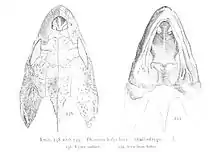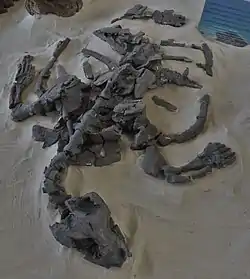Desmatochelys
Desmatochelys (from Greek δεσμός desmos 'link' + χέλῡς khelus ‘tortoise’) is an extinct genus of sea turtles belonging to the family Protostegidae.[2][3] This genus contains two known species, D. lowii and D. padillai. D. lowii was first discovered in 1895, followed by D. padillai in 2015. Having been estimated at over 120 million years old, D. padillai is currently the oldest known species of sea turtle.[4]
| Desmatochelys | |
|---|---|
 | |
| Scientific classification | |
| Kingdom: | Animalia |
| Phylum: | Chordata |
| Class: | Reptilia |
| Order: | Testudines |
| Suborder: | Cryptodira |
| Family: | †Protostegidae |
| Genus: | †Desmatochelys Williston, 1894 |
| Type species | |
| †Desmatochelys lowi Williston, 1894 | |
| Other species | |
| |
Desmatochelys lived during the Cretaceous, and had a wide geographic range, primarily along the Western Interior Seaway.[5]
Discovery
The first specimen of Desmatochelys was described by Samuel Wendell Willy in the Kansas University Quarterly in 1895. In his article he describes its discovery by a railroad worker near Fairbury, Nebraska. Williston was granted access to the specimen by his colleague M. A. Low, giving rise to the name ‘lowii’. This specimen was from the Late Cretaceous Benton Formation and included a nearly complete skull and lower jaw as well as pieces of the limbs, carapace, and plastron.[6] Since first being discovered, at least five new specimens of D. lowii have been described, found in South Dakota, Kansas, Arizona, Canada, and Mexico.[5]
D. padillai was first described in 2015 by paleontologists from the Senckenerg Research Institute and California State University. It was discovered in Colombia with the Lower Cretaceous Paja Formation. This placed its age around 120 million years, making it the oldest known sea turtle, a title which was previously held by Santanachelys gaffneyi.[4]
Description
Desmatochelys was a large sea turtle, with some specimens reaching up to 2 meters long.[4] Members of the genus are characterized by the extended skull roof, large nasal bones, and a paddle-like humerus, as well as a distinct body shell or carapace and reduced plastron like other protostegids.[7]

Specimens of Desmatochelys have been found in Nebraska, South Dakota, Kansas, Arizona, Canada, Colombia, and Mexico.[5] They are known to have existed along the Western Interior Seaway during the Late Cretaceous, and their range may have extended to the Pacific coast. Desmatochelys, like modern sea turtles, had a wide geographic distribution within the oceans.
As for its stratigraphic distribution, it is generally accepted that Desmatochelys was restricted to the Cretaceous, with occurrences ranging from the Barremian to the Campanian.[5]
Nothing is known of this turtle's reproductive strategy, with the exception of their egg development. Desmatochelys is hypothesized to have laid rigid eggs instead of the soft-shelled eggs typical of extant marine turtles, as a closely related protostegid has been shown to do.[8]
Taxonomy
The genus contains the following species:
Initially, Desmatochelys formed its own family, Desmatochelydae.[6] Later it was reassigned into the family Protostegidae. There is some debate among the paleontological community over the placement of Protostegidae (and therefore Desmatochelys) within turtle phylogeny.[4][9][10] According to Elizabeth L. Nicholls, the genus should also be expanded to include closely related members that currently belong to Notochelone and Rhinochelys.[11][12][10] As of 2019, Desmatochelys contains the two previously stated species, is within the family Protostegidae, and is placed along the stem of Chelonioidea - in other words, it is considered a basal turtle genus.[4][13]
References
- Edwin A. Cadena and James F. Parham (2015). "Oldest known marine turtle? A new protostegid from the Lower Cretaceous of Colombia". PaleoBios. 32 (1): 1–42.
- Karl, H. V., & Tichy, G. (2010). Maorichelys wiffeni n. gen. n. sp., una nueva tortuga marina del Eoceno de Nueva Zelanda (Testudines: Dermochelyidae).
- "Introduction to Testudines". UCMP Berkeley. Retrieved 25 April 2015.
- Cadena, Edwin A.; Parham, James F. (2015-09-07). "Oldest known marine turtle? A new protostegid from the Lower Cretaceous of Colombia". PaleoBios. 32 (1). ISSN 0031-0298.
- López-Conde, Oliver A.; Sterli, Juliana; Alvarado-Ortega, Jesús; Chavarría-Arellano, María L.; Porras-Múzquiz, Héctor (2019-10-01). "The first record of Desmatochelys cf. D. lowii from the Late Cretaceous (Campanian) of Coahuila, Mexico". Journal of South American Earth Sciences. 94: 102204. Bibcode:2019JSAES..9402204L. doi:10.1016/j.jsames.2019.05.020. ISSN 0895-9811.
- University of Kansas.; Kansas, University of (1894). The Kansas University quarterly. v.3 (1894-1895). Lawrence, Kansas: The University.
- "Desmatochelys". Paleos. Retrieved 18 September 2015.
- Cadena, Edwin-Alberto; Parra‐Ruge, Mary L.; Parra‐Ruge, Juan de D.; Padilla‐Bernal, Santiago (2019). "A gravid fossil turtle from the Early Cretaceous reveals a different egg development strategy to that of extant marine turtles". Palaeontology. 62 (4): 533–545. doi:10.1111/pala.12413. ISSN 1475-4983.
- Raselli, Irena (2018-12-07). "Comparative cranial morphology of the Late Cretaceous protostegid sea turtle Desmatochelys lowii". PeerJ. 6: e5964. doi:10.7717/peerj.5964. ISSN 2167-8359. PMC 6287587. PMID 30568851.
- G. E. Hooks, III (1998). "Systematic Revision of the Protostegidae, with a Redescription of Calcarichelys gemma Zangerl, 1953". Journal of Vertebrate Paleontology. 18 (1): 85–98. doi:10.1080/02724634.1998.10011036. ISSN 0272-4634. JSTOR 4523875.
- Calloway, Jack; Nicholls, Elizabeth, eds. (1997). Ancient Marine Reptiles. Academic Press. p. 243. ISBN 9780080527215.
- Nicholls, Elizabeth L. (1992-02-01). "Note on the occurrence of the marine turtle Desmatochelys (Reptilia: Chelonioidea) from the Upper Cretaceous of Vancouver Island". Canadian Journal of Earth Sciences. 29 (2): 377–380. Bibcode:1992CaJES..29..377N. doi:10.1139/e92-033. ISSN 0008-4077.
- Raselli, I. 2018. Comparative cranial morphology of the Late Cretaceous protostegid sea turtle Desmatochelys lowii. PeerJ 6:e5964 https://doi.org/10.7717/peerj.5964